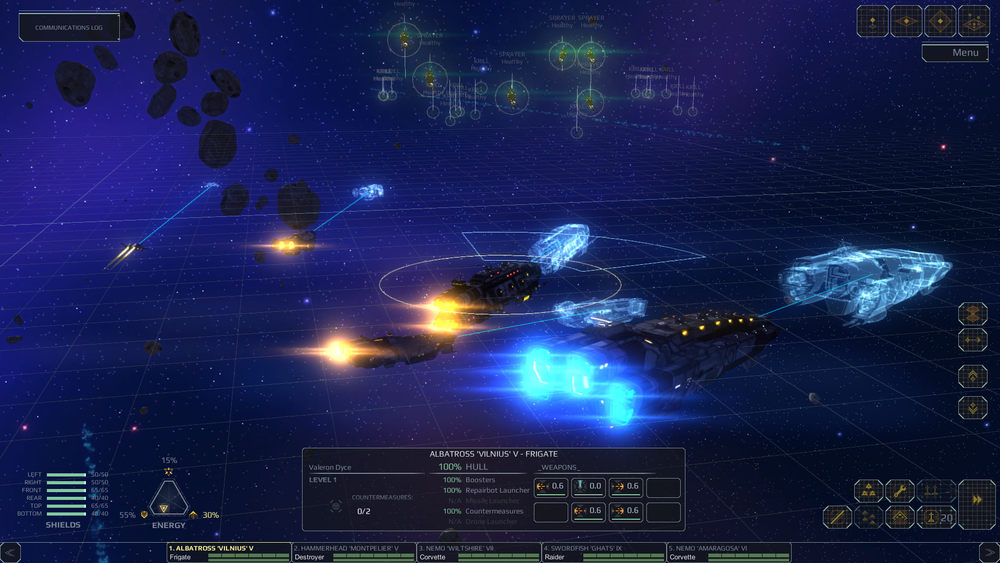Everspace is one of the best action rogue-lites to date, but it’s deceptively advertised. The trailers show your ship zooming at full speed and viciously dogfighting like this is the next coming of Freespace 2. It’s not, and the game it reminds me most of will surprise you. It’s Spelunky in space: 50% combat and 50% exploration/scavenging.

Mother-FUCK No Man’s Sky’s camera mode!
The premise of the game is you’re playing a succession of clones trying to figure out your purpose with the only clues being fractured memories from your original, the sardonic advice of your starfighter’s AI, and a distant set of coordinates. Unfortunately the coordinates lead you straight through a demilitarized zone full of pirates, hostile aliens, and other threats. What’s more, your hangar builds underpowered ships unless you can scavenge money for upgrades Rogue Legacy-style so you may have to burn through a few dozen bodies before you find the truth.
The gameplay is a Descent-style 6 degree of freedom shooter in a wide open arena filled with a heavy amount of asteroids, debris, and other terrain. You warp into an area, scope out interesting spots like shipwrecks or large asteroids, then in a limited amount of time fight and explore your way through them to gather as many resources as you can before a hostile army warps in.

Even “oh shit” moments like when your asshole ship AI warps you right into the corona of a star are just jaw-droppingly gorgeous
Like I said, even though it has the look of one, this is not a Freespace 2-style dogfighter. Without getting too technical, games like Wing Commander and Freespace 2 have seperate energy meters for guns and afterburners, allowing for nonstop action as the player juggles the two power sources when switching between attacking or evading. In Everspace your guns and afterburners use the same energy source, and when it runs out you’re out of options, save for missiles and consumables. Enough people were pointing this out in early access that it’s clear it was a deliberate choice by the game designers.
So what DOES Everspace play like? A tactical cover shooter in 3D. Every stage is strewn with asteroids, wreckage, and other potential cover, and a smart player will stick close to it because since every enemy has free movement in this game, you’re a sitting duck in open space. The biggest threat in this game is being outnumbered and shot from multiple angles, so you want to take out enemy forces piecemeal. Blow up an enemy at distance, duck behind cover to let your shields and energy recharge, use afterburners to flee to another safe spot when the main enemy force overruns your position and so on.

Shoulda stuck closer to the asteroids, buddy!
Like FTL, there’s a resource management element to combat. Can you finish these enemies with energy cannons alone, or are you going to have to burn through some missiles to survive? At any time you can pause the game and use resources to manufacture missiles and consumables, but unlike No Man’s Sky you can’t just top up your hit points and shields. There are a large variety of missiles you can manufacture, and the cheapest ones still pack a major punch even against capital ships if you spray them in a full alpha strike. You also want a cushion of resources because if enemies score a critical hit on your hull, they can knock out a subsystem and nearly cripple you until you scrape together the correct resources to repair it.
Which brings us to the other half of Everspace, the scavenging. The asteroids and wreckage all over the map aren’t just for cover, there’s gold in them thar hills! Your ship has a short range sensor which means you have to fly inside giant space hulks and asteroid tunnels to find the goodies within. Sometimes you’ll come across hidden pirate bases with juicy explosive tanks full of fuel and other resources. Sometimes wrecks are surrounded by deadly minefields that need to be destroyed (or need a wing of enemy fighter to fly through them). There are also neutral starfighters and stations from G&B Mining who can put you in a risk/reward situation of whether you should risk turning them hostle to steal their resources. But then again, if someone ELSE is shooting at you and in their zeal just HAPPEN to blow up some G&B shit, the neutrals will get angry at THEM and you get to scoop up the leftover fuel for free!

In order to get the “Return of the Jedi” obstacle course gameplay that every Descent clone must have by law, Everspace gives you limited time and a short sensor range, obligating you to zoom through the insides of these shipwrecks to reveal the space treasure chests hidden within.
Fortunately all that resource scavenging isn’t a chore thanks to the beautiful graphics. If you’re thinking of buying Hellblade and giving money to the studio that ruined Devil May Cry because the graphics for their crazy lady simulator are so pretty, consider spending that money instead on Everspace and get an actual game to go with the eye candy. As of this writing, Everspace is one of the most gorgeous space games on the PC and a real testament to what the Unreal engine’s capable of in the hands of a talented artist. Just the lighting alone is jaw-dropping.
Alas, that brings me to the negatives. First, the music sucks. I don’t know if they were trying to copy 65daysofstatic’s work on No Man’s Sky and failed, but if you want music that captures the grandeur of deep space, lay off the wah-wah pedal. This next may or may not be a negative for you, but like I said, there’s a whole Rogue Legacy system of upgrading ships with leftover money between missions, what I refer to as “unlock cancer,” that requires you to invest hours and hours into the game until you have a fully functional ship. At least there are cool visual changes to your ship’s model as you go up the trees. First-person cockpit mode is just for show and actually puts you at a disadvantage when navigating tight confines because you can’t see your wings. And finally, the game takes a little too long to start trotting out the more advanced enemy ships and for a player who’s still learning the ropes and struggling to get past sector 3 (of 7) the experience can be really samey.

Oh boy, I do so love having to grind for several playthroughs to unlock a fully functional game…
Everspace is a great game, but it’s not the game it looks like. If you want Freespace 2 with modern graphics, get Freespace Open. If you’re interested in a videogame adaptation of the 3D laser tag scenes from Ender’s Game (without the moronic dead legs exploit), give Everspace a try!
Encounters DLC
The main addition is a collection of NPC characters you can talk to and do side missions for. It’s like getting to know the companions in Shiren the Wanderer. Each time you finish their quests, you advance their storyline a step and eventually open up new gameplay options. For example, one character eventually teaches you to use wormholes to jump to an insanely dangerous area where you can steal a motherlode of a rare resource, another NPC teaches you to scan various species of space creatures for extra money. The game kindly displays their position on the sector map so you can pick which NPC’s story you want to advance this playthrough.
In addition, the DLC adds a new ship type (complete with its own upgrade tree) several new weapons and components, and lots of new space scenery, including G&B refining facilities where you can purchase new types of weapon upgrades, refine common resources into rare ones, and sometimes get a partial ship repair for free. Oh yeah, and one of the new weapons is a flamethrower.

SCIENCE!
If you’re buying Everspace, the Encounters DLC is pretty much a mandatory purchase because it directly addresses my biggest complaint: it solves the earlygame boredom problem by adding all sorts of stuff to do in the beginning sectors before the enemy difficulty and variety ramps up.
Comments? Join us on the forum.
 Mischief Maker
Mischief Maker





















